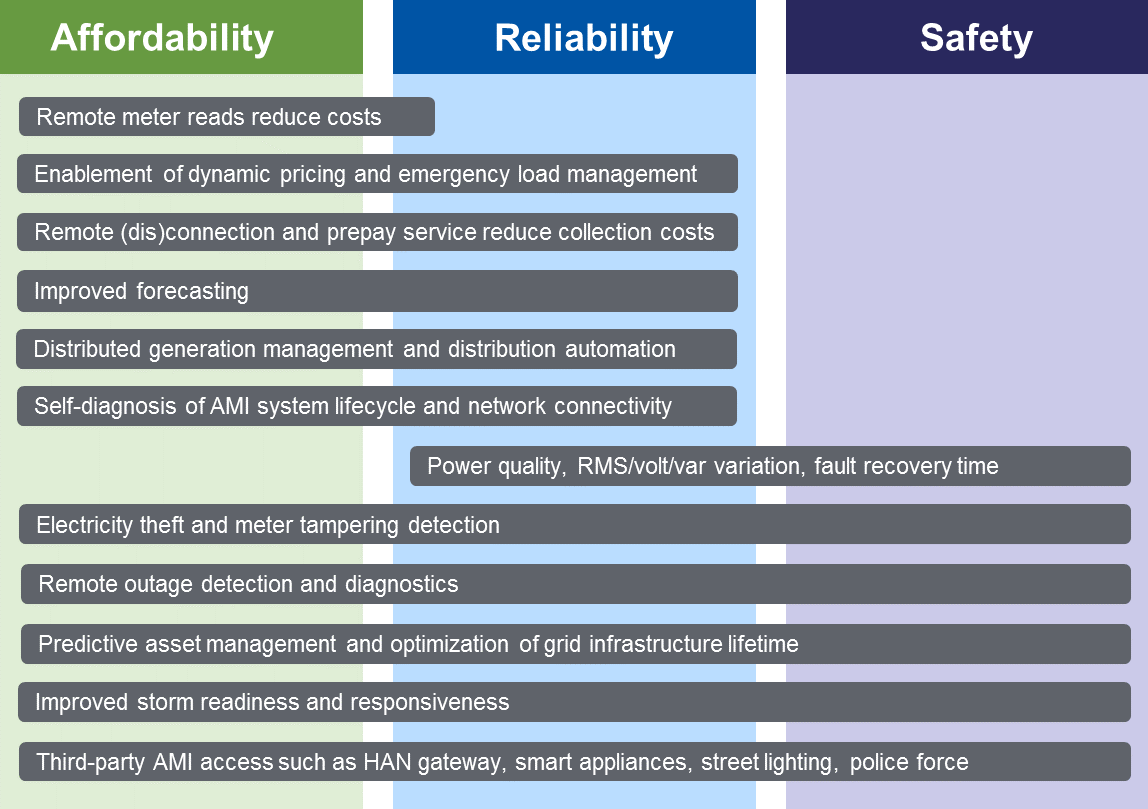Can grid modernization support utility core values?

Advanced Metering Infrastructure and Grid Modernization
The 2018 GridFWD conference, hosted by Smart Grid Northwest, convened around 250 energy service professionals in Vancouver, British Columbia. In a series of articles, Cadmus presents some key themes that emerged regarding grid modernization and the different pathways, priorities, and solutions discussed as next steps in moving this process forward.
By Joan Wang
Traditionally, utilities have provided power to their customers with several core values in mind: safety, reliability, and affordability. The public might associate utilities with images of power plants, distribution lines, and outage crews, but not so much with grid modernization. What does grid modernization look like in concrete ways? And how do aspects of grid modernization enhance utilities’ ability to deliver on their core values?
Advanced metering infrastructure (AMI) is one distinct vehicle of grid modernization. The Electric Power Research Institute defines AMI as “the full measurement and collection system that includes meters at the customer site, communication networks between the customer and a service provider… and data reception and management systems that make the information available to the service provider” (EPRI 2007). AMI makes customer-level energy usage visible at granular intervals and presents opportunities to educate customers regarding the variable price of energy through dynamic pricing programs. There are many use cases for grid modernization initiatives like AMI. For several utilities and vendors at the GridFWD conference, some of the most compelling use cases have been ones where AMI directly supports utilities’ core values.
Grid modernization can support a utility’s core values
Common reasons for utilities to install advanced meters relate to customer service, such as lowering meter reading costs, improved billing accuracy, provision of time-based rates, and enhanced awareness of real-time energy consumption (Mehra and Pateriya 2013). But with a forward-thinking vision, some utilities have identified ways to leverage AMI for grid-related use cases that also speak strongly to the utility’s core values.
At GridFWD’s Efficient Grid Ops session, Fiona Tayler, Director of Smart Technology Operations at BC Hydro, shared that BC Hydro has used AMI for a number of operational efficiency improvement purposes, such as using the meters to detect and disconnect vacant premises. Eighty percent of BC Hydro’s use cases for AMI have been related to improved operational efficiencies, enabling BC Hydro to decrease capital and operating costs and ensure affordability of power.
Electricity theft identification is one direct example of AMI’s use case for affordability of power. With advanced meters in place, BC Hydro was able to employ energy analytics models that inform how much power is flowing in and out of different points of the grid and identify instances of electricity theft. This AMI use case alone contributed several hundred million in benefits to their smart metering business case (20-year life, discounted) (Dell EMC 2017).
Along with saving ratepayers money, improved operational efficiencies also support the delivery of reliable power-another utility core value. One example is improving the management of grid infrastructure. Tom Martin, Managing Director of Product Management, Energy & Utilities at Trove, shared at GridFWD that AMI can enable a utility to better understand how assets are performing in real time and repair assets before outages occur. By studying voltage readings and signals from advanced meters, a utility could notice when voltage at a customer site is changing or identify issues with a transformer or service connection one or two days before any issues emerge-enough time to preemptively send crews to conduct repairs before an outage occurs. Becoming predictive in asset failure helps ensure continuous and reliable delivery of power and retain customer satisfaction. Moreover, the utility could generate more cost savings by planning repairs ahead of time, rather than sending repair crews on overtime.
AMI can also support grid-hardening efforts to improve storm readiness. Ankush Agarwal, Director of Advanced Analytics with Exelon Utilities, shared at GridFWD that one of Exelon Utilities, ComEd, is working on using machine learning on a variety of data to improve weather-related responsiveness. Equipped with higher-resolution weather data, advanced metered data on outages, and historical data on asset performance during storms, ComEd’s machine learning model can better predict storm outages and asset failures, assess damages, and estimate time of restoration. In doing so, ComEd can determine which assets to target for damage control during a storm that would optimize safety and reliability in its service area.

Collaboration and bundling of use cases are necessary to maximize benefits of grid modernization
The multiplicity of use cases for AMI is evident (see Figure 1). But how can these use cases be adopted and implemented?
At GridFWD, Fiona Tayler of BC Hydro emphasized the creation of a portfolio that bundles multiple use cases of AMI to ensure that AMI adoption is cost effective. She gave an example of BC Hydro combining traditional use cases of AMI that are customer-service-related with broader and forward-thinking grid-related use cases to ensure that enough value can be generated from AMI and other critical investments, such as telecom backhaul.
Ankush Agarwal of Exelon Utilities expressed a similar point of view: adopting one use case for AMI may not be economical, whereas combining AMI and other smart grid investments along the transmission and distribution system can help unlock a multitude of use cases related to asset health, storm readiness, network connectivity, and forecasting, all of which help improve reliability and reduce system risks (Agarwal 2017).
In addition, bundling some use cases with those that speak strongly to utility core values can make it easier to gain approval from the very top of the organization. Andy Gay, Program Manager for Advanced Utility Analytics at GE, shared that using qualitative benefits of certain use cases that speak to the safety component of utility core value- such as avoided fatalities-helps secure funding and sponsorship from the utility leadership for AMI and data analytics investments.
The bundling of use cases necessitates collaboration among different functions of the utility and with outside vendors. For example, Andy Gay of GE shared from a vendor’s perspective that ingesting AMI and other types of data at Exelon Utilities is a team sport that involves business operations, IT, and system integration, in addition to collaboration with many vendors. In this non-traditional vendor-customer relationship where many vendors are involved, Ankush Agarwal said it is important, too, to ensure that analytics initiatives are principally envisioned and led by utility employees, with vendors providing the support to realize the vision.
Moreover, as AMI data prove to be useful to different functions of the utility-across planning and operations and transmission and distribution-collaboration between these functions is necessary to support the distribution of information and maximize the number of beneficiaries to these data. Collaboration at a broader level can yield even more AMI benefits: Fiona Taylor of BC Hydro shared that the utility correlated power outage notifications and energy consumption profiles from advanced meters with tilt alarm data to identify homes that were likely owned by off-shore investors and targeted by a theft ring. Using this list of homes, the Royal Canadian Mounted Police and the Vancouver City Police were able to preempt and break up the theft ring’s criminal activity at the targeted homes. This goes to show that the benefits of grid modernization efforts such as AMI are numerous and waiting to be realized.
More GridFWD Insights
Accelerating Grid Modernization
The Future Grid: Collaboration or Competition Between Utilities and Tech Firms?
References
Agarwal, Ankush. “Grid Analytics Journey: Developing A Solid Strategy and Game Plan.” Presented at the second Smart Grids Big Data Spoke Workshop, College Station, Texas, April 18, 2017. Available online: http://smartgridcenter.tamu.edu/sgc/web/wp-content/uploads/2017/04/Agarwal_slides_shared_SGW5.pdf
Dell EMC. “BC Hydro reduces revenue loss with data lake and analytics.” 2017.
Electric Power Research Institute. Advanced Metering Infrastructure. February 2007. Available online: https://www.ferc.gov/CalendarFiles/20070423091846-EPRI%20-%20Advanced%20Metering.pdf
Electric Power Research Institute. AMI Security Acceleration Project: 1.1 AMI-SEC RA: Appendix A – Architectural Description. 2009.
Mehra, Tanvi and R. K. Pateriya. “Cyber Security Considerations for Advanced Metering Infrastructure in Smart Grid.” International Journal of Scientific & Engineering Research (2013): Volume 4, Issue 8. pp.939-944. Accessed January 2, 2019. Available online: https://www.ijser.org/researchpaper/Cyber-Security-Considerations-for-Advanced-Metering-Infrastructure-in-Smart-Grid.pdf